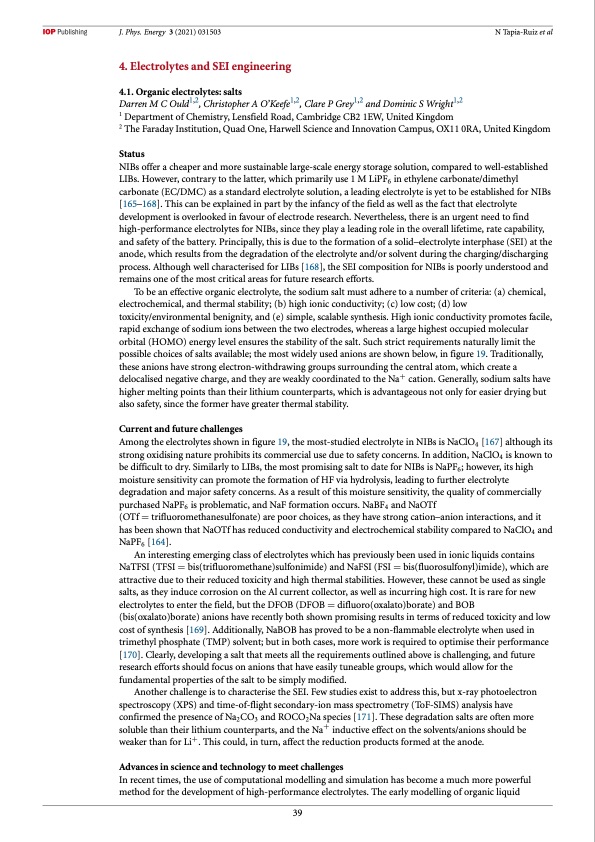
PDF Publication Title:
Text from PDF Page: 040
J. Phys. Energy 3 (2021) 031503 N Tapia-Ruiz et al 4. Electrolytes and SEI engineering 4.1. Organic electrolytes: salts Darren M C Ould1,2, Christopher A O’Keefe1,2, Clare P Grey1,2 and Dominic S Wright1,2 1 Department of Chemistry, Lensfield Road, Cambridge CB2 1EW, United Kingdom 2 The Faraday Institution, Quad One, Harwell Science and Innovation Campus, OX11 0RA, United Kingdom Status NIBs offer a cheaper and more sustainable large-scale energy storage solution, compared to well-established LIBs. However, contrary to the latter, which primarily use 1 M LiPF6 in ethylene carbonate/dimethyl carbonate (EC/DMC) as a standard electrolyte solution, a leading electrolyte is yet to be established for NIBs [165–168]. This can be explained in part by the infancy of the field as well as the fact that electrolyte development is overlooked in favour of electrode research. Nevertheless, there is an urgent need to find high-performance electrolytes for NIBs, since they play a leading role in the overall lifetime, rate capability, and safety of the battery. Principally, this is due to the formation of a solid–electrolyte interphase (SEI) at the anode, which results from the degradation of the electrolyte and/or solvent during the charging/discharging process. Although well characterised for LIBs [168], the SEI composition for NIBs is poorly understood and remains one of the most critical areas for future research efforts. To be an effective organic electrolyte, the sodium salt must adhere to a number of criteria: (a) chemical, electrochemical, and thermal stability; (b) high ionic conductivity; (c) low cost; (d) low toxicity/environmental benignity, and (e) simple, scalable synthesis. High ionic conductivity promotes facile, rapid exchange of sodium ions between the two electrodes, whereas a large highest occupied molecular orbital (HOMO) energy level ensures the stability of the salt. Such strict requirements naturally limit the possible choices of salts available; the most widely used anions are shown below, in figure 19. Traditionally, these anions have strong electron-withdrawing groups surrounding the central atom, which create a delocalised negative charge, and they are weakly coordinated to the Na+ cation. Generally, sodium salts have higher melting points than their lithium counterparts, which is advantageous not only for easier drying but also safety, since the former have greater thermal stability. Current and future challenges Among the electrolytes shown in figure 19, the most-studied electrolyte in NIBs is NaClO4 [167] although its strong oxidising nature prohibits its commercial use due to safety concerns. In addition, NaClO4 is known to be difficult to dry. Similarly to LIBs, the most promising salt to date for NIBs is NaPF6; however, its high moisture sensitivity can promote the formation of HF via hydrolysis, leading to further electrolyte degradation and major safety concerns. As a result of this moisture sensitivity, the quality of commercially purchased NaPF6 is problematic, and NaF formation occurs. NaBF4 and NaOTf (OTf = trifluoromethanesulfonate) are poor choices, as they have strong cation–anion interactions, and it has been shown that NaOTf has reduced conductivity and electrochemical stability compared to NaClO4 and NaPF6 [164]. An interesting emerging class of electrolytes which has previously been used in ionic liquids contains NaTFSI (TFSI = bis(trifluoromethane)sulfonimide) and NaFSI (FSI = bis(fluorosulfonyl)imide), which are attractive due to their reduced toxicity and high thermal stabilities. However, these cannot be used as single salts, as they induce corrosion on the Al current collector, as well as incurring high cost. It is rare for new electrolytes to enter the field, but the DFOB (DFOB = difluoro(oxalato)borate) and BOB (bis(oxalato)borate) anions have recently both shown promising results in terms of reduced toxicity and low cost of synthesis [169]. Additionally, NaBOB has proved to be a non-flammable electrolyte when used in trimethyl phosphate (TMP) solvent; but in both cases, more work is required to optimise their performance [170]. Clearly, developing a salt that meets all the requirements outlined above is challenging, and future research efforts should focus on anions that have easily tuneable groups, which would allow for the fundamental properties of the salt to be simply modified. Another challenge is to characterise the SEI. Few studies exist to address this, but x-ray photoelectron spectroscopy (XPS) and time-of-flight secondary-ion mass spectrometry (ToF-SIMS) analysis have confirmed the presence of Na2CO3 and ROCO2Na species [171]. These degradation salts are often more soluble than their lithium counterparts, and the Na+ inductive effect on the solvents/anions should be weaker than for Li+. This could, in turn, affect the reduction products formed at the anode. Advances in science and technology to meet challenges In recent times, the use of computational modelling and simulation has become a much more powerful method for the development of high-performance electrolytes. The early modelling of organic liquid 39PDF Image | 2021 roadmap for sodium-ion batteries

PDF Search Title:
2021 roadmap for sodium-ion batteriesOriginal File Name Searched:
roadmap-sodium-ion-batteries_031503.pdfDIY PDF Search: Google It | Yahoo | Bing
Salgenx Redox Flow Battery Technology: Salt water flow battery technology with low cost and great energy density that can be used for power storage and thermal storage. Let us de-risk your production using our license. Our aqueous flow battery is less cost than Tesla Megapack and available faster. Redox flow battery. No membrane needed like with Vanadium, or Bromine. Salgenx flow battery
| CONTACT TEL: 608-238-6001 Email: greg@salgenx.com | RSS | AMP |